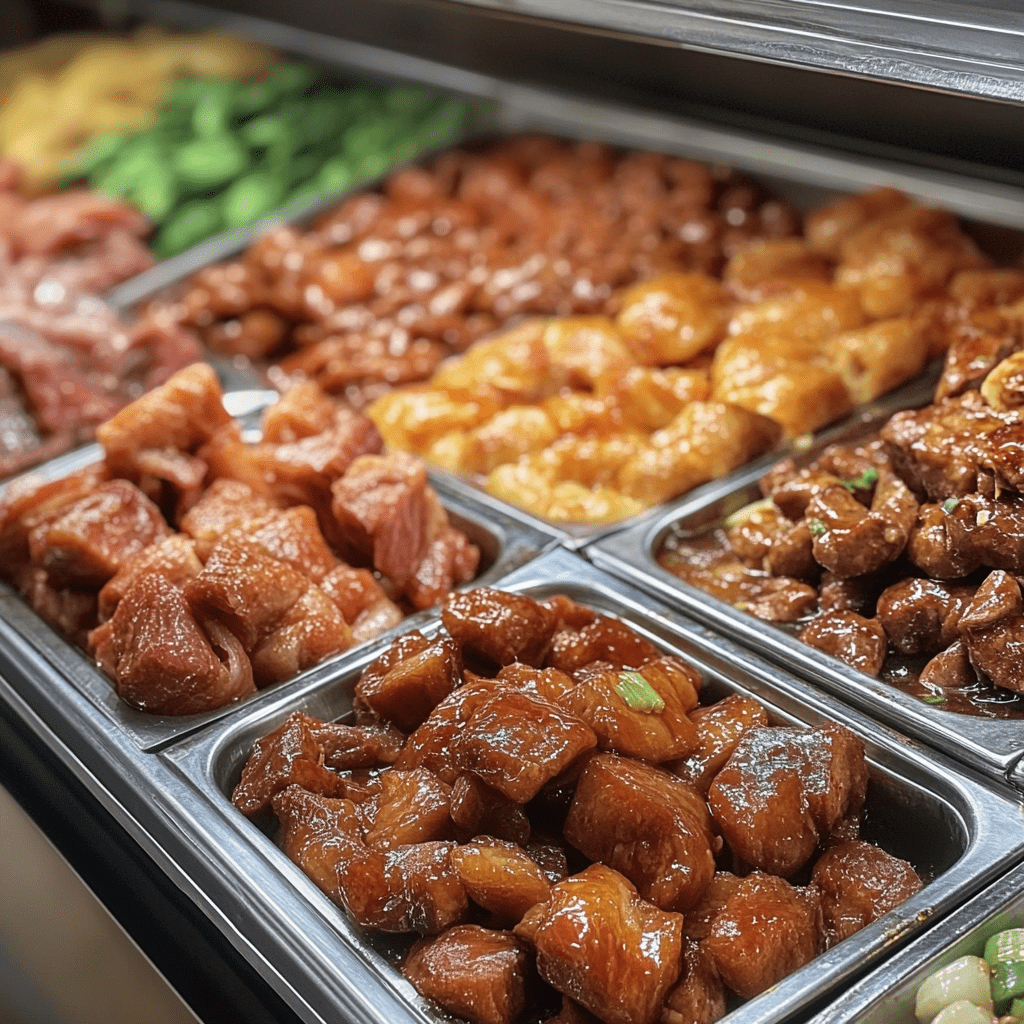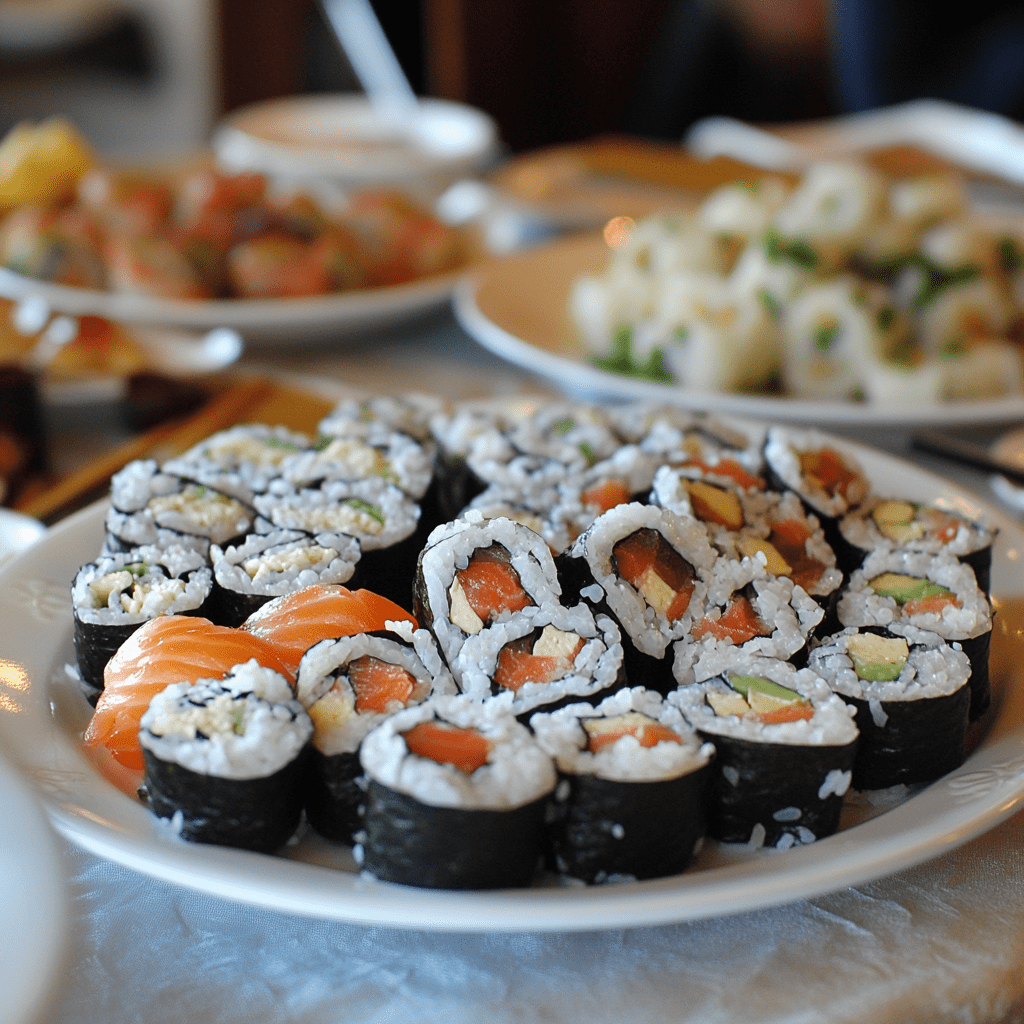Chinese buffets have become a staple of American dining, offering an all-you-can-eat experience that seems too good to be true. However, navigating these expansive spreads can be tricky. While the allure of endless options is strong, not all dishes are created equal. Some may compromise your health, while others simply don’t offer the authentic flavors of traditional Chinese cuisine. This guide will help you make informed choices the next time you find yourself at a Chinese buffet.
Steer clear of room temperature meats

One of the biggest red flags at any buffet is meat dishes sitting at room temperature. Bacteria thrive in this environment, multiplying rapidly and increasing the risk of foodborne illnesses. Pay attention to dishes like sweet and sour chicken, beef with broccoli, or General Tso’s chicken. If they’re not steaming hot or sitting in a heated tray, it’s best to skip them. Opt instead for dishes that are being actively replenished or those kept at proper temperatures in chafing dishes.
What if you’re craving meat? Look for stations where chefs are cooking fresh to order, such as a Mongolian grill. This ensures your food is cooked thoroughly and served at a safe temperature. Remember, no amount of delicious sauce is worth the risk of food poisoning.
Avoid dishes with a suspicious appearance
Your eyes can be your best defense at a buffet. Be wary of dishes that look dry, discolored, or have a strange texture. For example, if the fried rice looks pale and clumpy rather than fluffy and vibrant, it may have been sitting out for too long. Similarly, if the vegetables in a stir-fry dish appear wilted or slimy, they’re past their prime.
Pay special attention to seafood dishes. If the shrimp in the shrimp fried rice looks grey instead of pink, or if the fish in any dish has a strong odor, these are clear signs to stay away. Fresh seafood should have a mild scent and appear moist but not slimy.
Be cautious with sushi at non-specialized buffets

Sushi at a Chinese buffet might seem like a good idea, but it’s often best avoided unless you’re at a specialized sushi restaurant. The quality of fish used in buffet sushi may not be up to par with dedicated sushi establishments. Moreover, raw fish requires careful handling and temperature control to remain safe for consumption.
If you’re really craving sushi, look for vegetarian options like cucumber or avocado rolls. These are safer choices as they don’t contain raw fish. Alternatively, consider cooked sushi options like tempura rolls if available. Remember, when it comes to raw fish, it’s always better to err on the side of caution.
Skip the egg foo young
Egg foo young, while a popular dish, is often not the best choice at a Chinese buffet. These egg patties are typically pre-made and left to sit under heat lamps, which can lead to a rubbery texture and potential safety issues. The dish can quickly become dry and unappetizing, losing its original flavor and consistency.
If you’re looking for an egg dish, consider alternatives like egg drop soup, which is usually made fresh and served hot. Or, if available, ask if the buffet offers made-to-order omelets, which would be a fresher and safer option.
Pass on the crispy noodles
Those crunchy noodles often found at the start of the buffet line might seem harmless, but they’re best avoided. These fried noodles are often left out for extended periods, exposed to air and potential contaminants. They can quickly become stale or absorb moisture from the air, losing their crunch and potentially harboring bacteria.
Instead, opt for freshly cooked noodle dishes like lo mein or chow mein. These dishes are typically served hot and replenished more frequently, ensuring a better taste and reduced risk of foodborne illness.
Be wary of the crab rangoon

Crab rangoon, those crispy wontons filled with a cream cheese mixture, can be a delicious treat. However, at a buffet, they can quickly become soggy and unappetizing. The cream cheese filling can also reach unsafe temperatures if left out for too long, potentially leading to bacterial growth.
If you’re craving something crispy and filled, look for spring rolls or dumplings that are being freshly fried or steamed. These options are more likely to maintain their texture and are typically served at safer temperatures.
Avoid the soft serve ice cream machine
While it might be tempting to end your meal with a swirl of soft serve, these machines can be breeding grounds for bacteria if not properly maintained. The mixture inside can quickly become a haven for harmful microorganisms if the temperature isn’t consistently regulated.
For a safer dessert option, look for individually wrapped fortune cookies or almond cookies. If the buffet offers fresh fruit, that’s an even better choice to end your meal on a sweet note.
Think twice about the “americanized” chinese dishes
Dishes like General Tso’s chicken, sweet and sour pork, and chop suey, while popular, are often far removed from authentic Chinese cuisine. These Americanized versions typically contain more sugar, salt, and fat than traditional Chinese dishes. At a buffet, they’re often made in large batches and may sit out for extended periods, compromising both flavor and nutritional value.
Instead, look for dishes that resemble more traditional Chinese fare. Options like stir-fried vegetables, steamed fish, or tofu dishes are often healthier and more authentic. They’re also more likely to be replenished frequently due to their popularity among Chinese patrons.
Be cautious with buffet sauces and condiments
Sauce stations at buffets can be problematic. Containers are often left out for long periods and may not be cleaned thoroughly between refills. This creates an environment where bacteria can thrive. Additionally, shared serving utensils can lead to cross-contamination between different sauces.
If you need to add some flavor to your dish, look for individually packaged sauces or ask a staff member if they can provide freshly prepared sauce from the kitchen. This reduces the risk of consuming contaminated condiments.
Navigating a Chinese buffet doesn’t have to be a daunting task. By being mindful of these potential pitfalls, you can enjoy a safer and more authentic dining experience. Remember, freshness is key. Opt for dishes that are being actively replenished, stay hot, and look appetizing. Don’t be afraid to ask staff about the preparation methods or ingredients if you’re unsure.
What if you find yourself at a buffet where many dishes seem questionable? In that case, it might be best to stick to simple, cooked vegetables and rice dishes. Or consider finding a different restaurant altogether. Your health and enjoyment of the meal should always come first.
By making informed choices, you can still enjoy the variety and value that Chinese buffets offer while minimizing risks. And who knows? You might discover some new favorite dishes that are both delicious and authentic representations of Chinese cuisine.


